Creating beautiful memories since 1727 AD
Jaipur is an epitome of vibrant culture, colourful traditions and glorious history. Popularly known as 'The Pink City', Jaipur was founded in 1727 AD by Sawai Jai Singh II of Amer. Immaculately planned, it was amongst the first few planned cities in the Indian subcontinent.
Today, Jaipur is one of the most popular tourist destinations in Northern India. One of the many reasons that intrigue and attract visitors from every corner of the world is the perfect blend of heritage and modernity that this city exudes.
Calm and moderately populated, Jaipur is well connected by different modern means of public transportation. The roads are wide and not crowded. Travel from one corner of the city to another easy and convenient. Accommodation facilities in the Pink City include world-class five star hotels, heritage hotels, luxury resorts, home-stays and business hotels. The city offers ample options to the visitors for a comfortable and memorable stay.
A city to discover - What you shouldn't miss
Famous world over as a 'must-visit' tourist destination, the city is home to many beautiful historical monuments and forts. With its splendid forts, majestic palaces, tranquil temples & beautiful havelis, Jaipur has something for everyone.
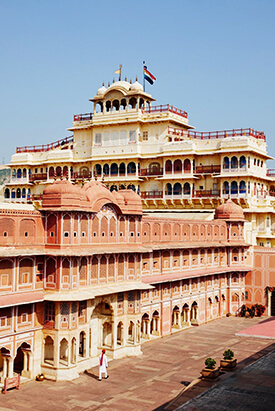
The City Palace - Revere the palatial grandeur
Home to several majestic structures, the city palace is a masterpiece of Rajasthani and Mughal architecture. Built by Maharaja Sawai Jai Singh II, the palace covers one seventh of the walled city and is separated by a series of vast courtyards, lush green gardens and buildings. Visitors can enjoy various aspects of the palace which include the 'Maharaja Sawai Man Singh II Museum', 'Diwan-e-Khas' (hall of private audience), 'Diwan-e-Aam' (hall of public audience), 'Ridhi Sidhi Pol' (four corners depicting four seasons), 'Chandra Mahal' (the moon palace), 'Sukh Nivas' (resting hall), 'Shobha Nivas' (hall of beauty), 'Chhavi Nivas' (hall of images), 'Mukut Mahal' (the crown building) and the 'Badal Mahal'.
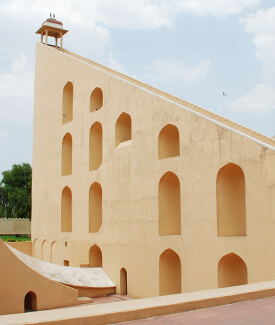
Jantar Mantar - Your ticket to the sun and the stars
A UNESCO world heritage site, the Jantar Mantar is an astronomical observation site built in the early 18th century. It includes a set of about 20 main fixed instruments. They are monumental examples in masonry of known instruments but which in many cases have specific characteristics of their own. Designed for the observation of astronomical positions with the naked eye, they embody several architectural and instrumental innovations. This is the most significant, most comprehensive, and the best preserved of India's historic observatories. The monument is an expression of finesse in astronomical skills and cosmological concepts. The term 'Jantar Mantar' is derived from the Sanskrit terms 'Yantra' and 'Mantra' meaning 'instruments' and 'formula' respectively. The term 'Yantra' was replaced with 'Jantar' which means 'magical'.
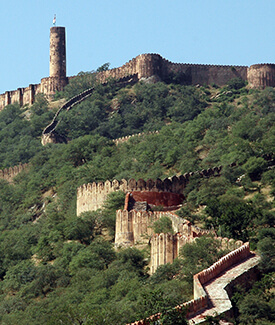
Jaigarh Fort - Visualise valour and bravery
With its walls spread over three kilometers, the Jaigarh fort tells tales of valour and bravery of Rajput warriors. The fort is an incredible display of the military architecture and literally means the 'Fort of Victory'. The highlight here is the 'Jaivan Cannon', the world's largest cannon on wheels. The tough exterior of the fort gracefully encloses palaces, gardens, open and covered reservoirs, a granary, an armoury, a well-planned cannon foundry and several temples.
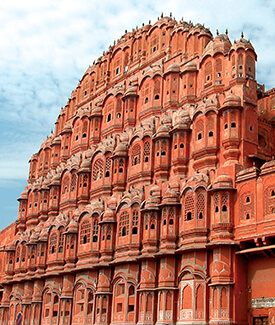
Hawa Mahal - Backdrop for the perfect Jaipur Selfie
A major landmark of Jaipur, the pink sandstone windows or the 'Jharokas' were built by Maharaja Sawai Pratap Singh in 1799 for the women of royal families to watch and enjoy the processions and different activities taking place on the market streets. An experience of true splendor, Hawa Mahal literally means 'the palace of winds'. The unique and extraordinary monument is a perfect mix of Rajput and Mughal architectural design.
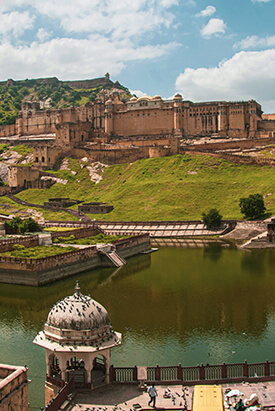
Amber Fort - Lose yourself in a fairytale palace
Witness to history unfolding in its lap for centuries, Amber still stands with the same pride with which it once played abode to the royal families. A complex with gateways, gardens, halls, stairways, pillared pavilions, temples and palaces; Amber Fort is located 10 kilometres from the centre of Jaipur city on the Jaipur-Delhi highway. The fort has four sections. The gates, Surajpol (on the east) or Chandpol (on the west) lead to the 'Jaleb Chowk' (the main courtyard) from where the returning armies were welcomed to display their war earnings to the population at large. The main stairways lead to the second courtyard of the fort, the grand 'Diwan-e-Aam' (hall of public audiences) where the Maharaja received the populace and their petitions. Behind the magnificent 'Ganesh Pol', is the 'Diwan-e-Khas' (hall of private audience); 'Sukh Niwas' (residential apartment) of Maharaja and the extravagant 'Sheesh Mahal'. These lead to the forth courtyard, the 'Zanana Mahal' (palace of queens).
Walled City - Shop till you drop
True to the name 'Pink City', the walled city in the Jaipur is a shopper's delight. Numerous age old bazaars capture the real essence of Jaipuri art and handicraft. From 'Kundan' style jewellery and exotic blue pottery to block printed textiles and tie & dye fabrics, (the local shoe), to beautiful stone carvings, you will find the best of Rajasthan here.

-
Johari Bazar
With numerous highly skilled establishments that offer gold and silver jewellery, traditional tie and dye fabrics, textiles and mojaris, colourful spices and churans and small eateries of traditional Jaipuri food. This not to miss bazaar is dotted with many beautiful temples.
-
Tripolia Bazar and Chaura Rasta
If you want to see the artisans at work, step into the by-lanes and see master artisans at work. One can shop here for utensils, ironware and trinkets.
-
Bapu Bazaar and Nehru Bazaar
Perfect market to purchase textiles, local perfumes and shoes and bags made of camel skin.
-
Mirza Ismail Road (M.I. Road)
The broad thoroughfare houses a large number of emporia selling a variety of goods ranging from jewellery and brass work to textiles, to blue pottery, to woodwork, etc. The road also has many modern restaurants that offer both Indian and western cuisine.


